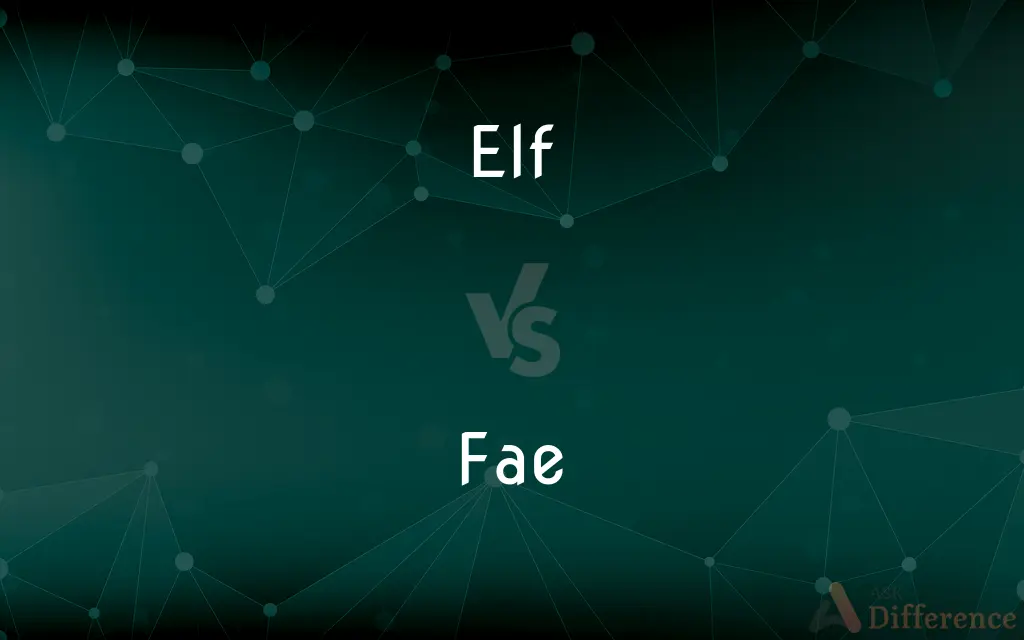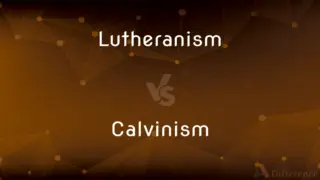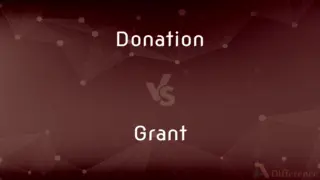Elf vs. Fae — What's the Difference?
By Maham Liaqat & Urooj Arif — Updated on March 25, 2024
Elves are mythical beings from Germanic folklore, often depicted as powerful and immortal, whereas fae (or faeries) encompass a broader category of magical beings from various mythologies, not limited by specific traits.

Difference Between Elf and Fae
Table of Contents
ADVERTISEMENT
Key Differences
Elves, originating from Germanic mythology and folklore, are typically portrayed as humanoid beings with supernatural abilities, immortality, and a close connection to nature. They appear in various European mythologies with traits ranging from benevolent to malevolent. On the other hand, the term fae, short for faeries, refers to a wide array of mythical beings found in multiple cultures, including elves but also extending to sprites, pixies, nymphs, and more, each with their unique attributes and stories.
While elves are often associated with specific qualities such as elegance, superior craftsmanship, and living in hidden, enchanted realms, the fae encompass a much wider spectrum of characteristics and moral alignments. Fae can range from mischievous or benevolent beings like the Irish leprechaun to darker entities such as the Scottish banshee. This diversity makes the fae category more inclusive and varied compared to the more narrowly defined elves.
In literature and popular culture, elves have been popularized by works like J.R.R. Tolkien's Middle-earth legendarium, which portrays them as wise, ancient, and closely connected to the natural world. In contrast, fae have been depicted in a myriad of ways, from the whimsical and gentle fairies of children's tales to the complex, morally ambiguous characters in modern fantasy literature and folklore, demonstrating their adaptability to different narratives.
The habitat of elves is often described as ethereal and secluded, such as magical forests or hidden elven kingdoms, emphasizing their connection to nature and otherworldliness. Meanwhile, fae can be found in a variety of settings, from the rural, pastoral landscapes inhabited by fairies to the more sinister and foreboding realms of other fae beings, reflecting the diversity within the fae classification.
The interaction of elves and humans in mythology and literature is frequently portrayed as rare and significant, often involving quests or alliances. In contrast, fae-human interactions cover a broader range, including helpful guidance, trickery, or even hostile encounters, depending on the nature of the fae involved. This illustrates the more unpredictable and varied nature of fae compared to the typically more aloof and dignified elves.
ADVERTISEMENT
Comparison Chart
Origin
Germanic folklore
Various mythologies
Traits
Immortal, nature-connected, elegant
Broad spectrum, from benevolent to malevolent
Cultural Representation
High craftsmanship, wisdom
Mischievous, magical, diverse in morality
Habitat
Hidden realms, forests
Varied, from pastoral landscapes to dark realms
Interaction with Humans
Rare and significant
Broad range, from helpful to hostile
Compare with Definitions
Elf
Lives in hidden or magical places.
She stumbled upon an elven kingdom, hidden by spells.
Fae
Fae can be good, evil, or neutral.
The fae tricked travelers, leading them astray.
Elf
Known for their superior craftsmanship.
The elven smiths forged weapons of unparalleled beauty.
Fae
Many fae have strong ties to natural elements.
Forest fae nurtured the blooming flowers.
Elf
Often portrayed as protectors of natural realms.
Elves in the tale guarded the sacred grove.
Fae
Encompasses all creatures with magical traits.
The fae danced under the moonlit sky.
Elf
Elves are depicted as wise beings with long lifespans.
The elf shared tales from centuries past.
Fae
Includes fairies, pixies, and more.
The garden was said to be home to various fae.
Elf
A creature from Germanic folklore with magical powers.
The elf silently moved through the ancient forest.
Fae
Their interactions with humans vary widely.
The fae offered guidance to the lost child.
Elf
(Norse mythology) A luminous spirit presiding over nature and fertility and dwelling in the world of Álfheim (Elfland). Compare angel, nymph, fairy.
Fae
Alternative spelling of fey
Elf
An elf (plural: elves) is a type of humanoid supernatural being in Germanic mythology and folklore (especially North Germanic mythology and folklore). In medieval Germanic-speaking cultures, elves generally seem to have been thought of as beings with magical powers and supernatural beauty, ambivalent towards everyday people and capable of either helping or hindering them.
Fae
Alternative spelling of fey
Elf
A mythical creature in human form but usually smaller, often considered mischievous.
Fae
A gender-neutral third-person singular subject pronoun, equivalent to singular he and she.}}
Elf
A lively, mischievous child.
Fae
A device consisting of a container of fuel and two explosive charges; the first charge bursts open the fuel container at a predetermined height and spreads the fuel in a cloud that mixes with atmospheric oxygen; the second charge detonates the cloud which creates an enormous blast wave and incinerates whatever is below
Elf
A usually sprightly or mischievous or sometimes spiteful person.
Elf
Any from a race of mythical, supernatural beings resembling but seen as distinct from human beings. They are usually delicate-featured and skilled in magic or spellcrafting; sometimes depicted as clashing with dwarves, especially in modern fantasy literature.
Elf
(fantasy) Any of the magical, typically forest-guarding races bearing some similarities to the Norse álfar (through Tolkien's Eldar).
Elf
A very diminutive person; a dwarf.
Elf
(South Africa) The bluefish (Pomatomus saltatrix).
Elf
To twist into elflocks (of hair); to mat.
Elf
An imaginary supernatural being, commonly a little sprite, much like a fairy; a mythological diminutive spirit, supposed to haunt hills and wild places, and generally represented as delighting in mischievous tricks.
Every elf, and fairy sprite,Hop as light as bird from brier.
Elf
A very diminutive person; a dwarf.
Elf
To entangle mischievously, as an elf might do.
Elf all my hair in knots.
Elf
(folklore) fairies that are somewhat mischievous
Elf
Below 3 kilohertz
Common Curiosities
What defines an elf in mythology?
Elves are defined by their immortality, connection to nature, and often superior abilities or knowledge.
How are fae different from elves?
Fae is a broader category that includes elves but also other magical beings, each with unique traits and origins.
Can elves be considered fae?
Yes, elves can be considered a type of fae within the broader classification of magical beings.
How do elves and fae interact with their environments?
Elves are typically seen as guardians of nature, while fae might inhabit or influence various natural and supernatural realms.
Are all fae friendly towards humans?
Fae interactions with humans vary, ranging from benevolent to malevolent, depending on the folklore.
What role do elves play in fantasy literature?
Elves often play roles as allies, wise counselors, or skilled warriors in fantasy literature.
How do beliefs in fae vary across cultures?
Beliefs in fae vary widely, reflecting the diverse mythologies and folk traditions from which they originate.
What is the most common portrayal of elves in modern culture?
In modern culture, elves are often portrayed as wise, nature-bound beings with a penchant for artistry and magic.
What is a common theme in stories involving elves?
A common theme is the elves' struggle to maintain their realms and way of life in a changing world.
How are fae viewed in contemporary fantasy fiction?
Contemporary fantasy often presents fae as complex characters, capable of both kindness and cruelty.
What distinguishes dark fae from other fae?
Dark fae are often characterized by malevolent intentions or actions, contrasting with more benign fae.
Can fae change their appearance?
In many stories, fae possess the ability to change their appearance or become invisible to humans.
Is belief in elves and fae still present today?
While not widely held as literal belief, interest in elves and fae persists in cultural and entertainment contexts.
How has the depiction of elves evolved over time?
Depictions of elves have evolved from mischievous or divine beings in folklore to noble, sophisticated characters in modern fantasy.
Do elves and fae always possess supernatural powers?
While typically attributed supernatural powers, the specific abilities of elves and fae vary by tradition.
Share Your Discovery

Previous Comparison
Lutheranism vs. Calvinism
Next Comparison
Donation vs. GrantAuthor Spotlight
Written by
Maham LiaqatCo-written by
Urooj ArifUrooj is a skilled content writer at Ask Difference, known for her exceptional ability to simplify complex topics into engaging and informative content. With a passion for research and a flair for clear, concise writing, she consistently delivers articles that resonate with our diverse audience.














































